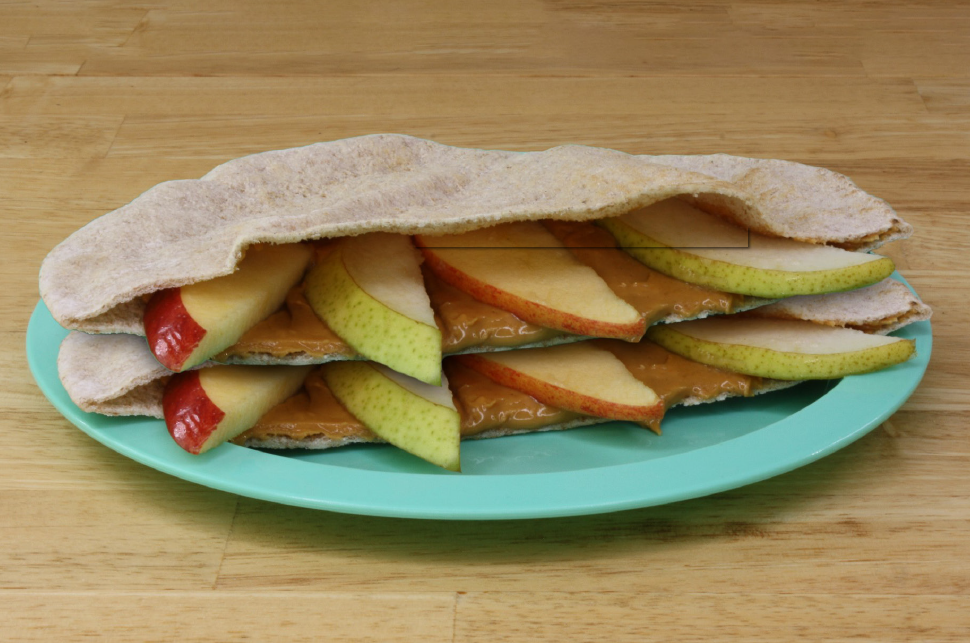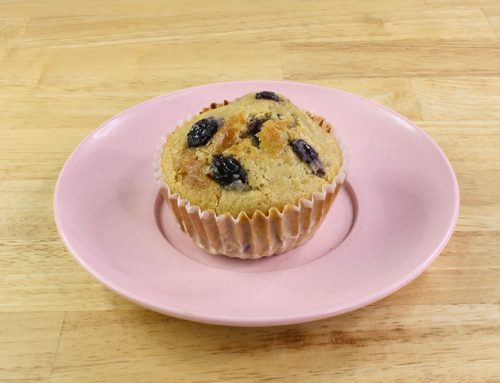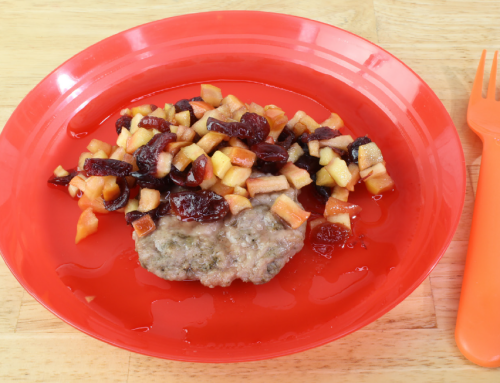Fruit and Nut Butter Pita Pockets USDA Recipe for Family Child Care Homes
Age Group: Ages 6-18
Serving Size: 6
Pita pockets are great for stuffing, and this grab-and-go breakfast is sure to please. Apples, pears, and peanut butter are packed into a whole grain-rich pita to create a tasty meal kids will enjoy.CACFP CREDITING INFORMATION½ cup fruit1 oz eq meat alternate2 oz eq grains
Ingredients
- 6 - Pita rounds, whole-wheat (at least 56 g or 2 oz each)
- ¾ cup - Peanut butter, smooth
- 12 slices Apples, fresh, unpeeled, cored, ¼" slices (~2 medium apples; gently wash apples under running water before cutting)
- 14 slices D'Anjou pears, red, fresh, unpeeled, cored, ¼" slices (~2 large pears; gently wash pears under running water before cutting)
Quantity
- 6 - Pita rounds, whole-wheat (at least 56 g or 2 oz each)
- ¾ cup - Peanut butter, smooth
- 12 slices Apples, fresh, unpeeled, cored, ¼" slices (~2 medium apples; gently wash apples under running water before cutting)
- 14 slices D'Anjou pears, red, fresh, unpeeled, cored, ¼" slices (~2 large pears; gently wash pears under running water before cutting)
Ingredients
- 6 - Pita rounds, whole-wheat (at least 56 g or 2 oz each)
- ¾ cup - Peanut butter, smooth
- 12 slices Apples, fresh, unpeeled, cored, ¼" slices (~2 medium apples; gently wash apples under running water before cutting)
- 14 slices D'Anjou pears, red, fresh, unpeeled, cored, ¼" slices (~2 large pears; gently wash pears under running water before cutting)
Quantity
- 6 - Pita rounds, whole-wheat (at least 56 g or 2 oz each)
- ¾ cup - Peanut butter, smooth
- 12 slices Apples, fresh, unpeeled, cored, ¼" slices (~2 medium apples; gently wash apples under running water before cutting)
- 14 slices D'Anjou pears, red, fresh, unpeeled, cored, ¼" slices (~2 large pears; gently wash pears under running water before cutting)
*See Marketing Guide
Ingredients
- 6 - Pita rounds, whole-wheat (at least 56 g or 2 oz each)
- ¾ cup - Peanut butter, smooth
- 12 slices Apples, fresh, unpeeled, cored, ¼" slices (~2 medium apples; gently wash apples under running water before cutting)
- 14 slices D'Anjou pears, red, fresh, unpeeled, cored, ¼" slices (~2 large pears; gently wash pears under running water before cutting)
Quantity
- 6 - Pita rounds, whole-wheat (at least 56 g or 2 oz each)
- ¾ cup - Peanut butter, smooth
- 12 slices Apples, fresh, unpeeled, cored, ¼" slices (~2 medium apples; gently wash apples under running water before cutting)
- 14 slices D'Anjou pears, red, fresh, unpeeled, cored, ¼" slices (~2 large pears; gently wash pears under running water before cutting)
*See Marketing Guide
Ingredients
- 6 - Pita rounds, whole-wheat (at least 56 g or 2 oz each)
- ¾ cup - Peanut butter, smooth
- 12 slices Apples, fresh, unpeeled, cored, ¼" slices (~2 medium apples; gently wash apples under running water before cutting)
- 14 slices D'Anjou pears, red, fresh, unpeeled, cored, ¼" slices (~2 large pears; gently wash pears under running water before cutting)
Quantity
- 6 - Pita rounds, whole-wheat (at least 56 g or 2 oz each)
- ¾ cup - Peanut butter, smooth
- 12 slices Apples, fresh, unpeeled, cored, ¼" slices (~2 medium apples; gently wash apples under running water before cutting)
- 14 slices D'Anjou pears, red, fresh, unpeeled, cored, ¼" slices (~2 large pears; gently wash pears under running water before cutting)
*See Marketing Guide
Ingredients
- 6 - Pita rounds, whole-wheat (at least 56 g or 2 oz each)
- ¾ cup - Peanut butter, smooth
- 12 slices Apples, fresh, unpeeled, cored, ¼" slices (~2 medium apples; gently wash apples under running water before cutting)
- 14 slices D'Anjou pears, red, fresh, unpeeled, cored, ¼" slices (~2 large pears; gently wash pears under running water before cutting)
Quantity
- 6 - Pita rounds, whole-wheat (at least 56 g or 2 oz each)
- ¾ cup - Peanut butter, smooth
- 12 slices Apples, fresh, unpeeled, cored, ¼" slices (~2 medium apples; gently wash apples under running water before cutting)
- 14 slices D'Anjou pears, red, fresh, unpeeled, cored, ¼" slices (~2 large pears; gently wash pears under running water before cutting)
*See Marketing Guide
Instructions
- Wash hands with soap and water for at least 20 seconds.
- Cut each pita round in half.
- Spread 1 Tbsp of peanut butter in each pita pocket half.
- Cut apple and pear slices in half. Place 2 pieces of apple in each pita pocket half.
- Place 2–3 pieces of pear in each pita pocket half.
- Serve 2 halves fruit and nut butter pita pocket. Serve immediately, or keep cold at 40 °F or lower.
Nutrition INFORMATION
Fruit and Nut Butter Pita Pockets USDA Recipe for Family Child Care Homes
Amount Per Serving
2 halves Fruit and Nut Butter Pita Pocket
Calories
406
Total Fat
14
g
22
%
Saturated Fat
2
g
13
%
Sodium
490
mg
21
%
Total Carbohydrate
61
g
20
%
Dietary Fiber
8
g
33
%
Total Sugars
12
g
13
%
Protein
16
g
32
%
Calcium
29
mg
3
%
Iron
3
mg
17
%
N/A=data not available
*Marketing Guide
The CHEF TIPS:
- Contains wheat (pita) and peanuts (peanut butter). Pita rounds can be a hidden source of common allergens which include, milk, peanuts, tree nuts, eggs, fish, shellfish, soy, wheat, and sesame.
- Sesame can appear as an ingredient in foods where it might not be expected (pita rounds) and may be included in ingredient statements as “spice” or “flavoring”.
- Sunflower seed butter or soy nut butter may be used in place of peanut butter. Some sunflower seed butters and soy nut butters are produced on equipment shared with tree nuts and, in some cases, peanuts.
- To keep fresh cut fruit from turning brown, coat them with an acidic juice, such as lemon or orange, or use a commercial anti-darkening agent.
- Meats/meat alternates may be served in place of the entire grains component up to 3 times per week at breakfast in the CACFP.
- For breakfast, you can credit the grains or meats/meat alternates in this recipe toward the reimbursable meal.
- The symbol indicates the recipe is whole grain-rich.
- Creditable grains contribution calculated using the Recipe Analysis Workbook, Method A.
Yield / Volume



